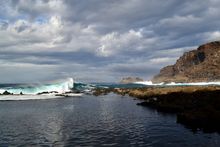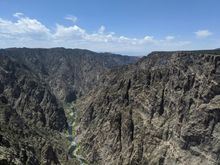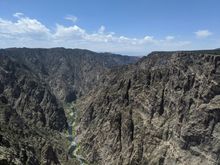 15 Oct 2025
15 Oct 2025
Tags: Adventure, Sustainable Tourism, Travel, travelapp, travelswaps, Greenland, Japan, China, New Zealand, Thailand, south africa, Colorado, Black Canyon, Venice, Mexico, Peru

With many of the world's must-see tourist sites now overwhelmed by visitors, travel experts at Polarsteps are encouraging explorers to take a different route, offering inspiring alternatives that help you unfollow the crowds.
Trusted by more than 17 million travellers worldwide, Polarsteps has become one of Europe's leading travel apps and is among the fastest-growing in the UK (Similarweb). Its mission is simple: to help people step off the conveyor belt of “must-sees” and rediscover the joy of genuine adventure.
Every traveller wants to see the world's A-list attractions — and that's the problem. As overtourism chips away at the charm of once-breathtaking beauty spots, strains ancient relics, and makes our experiences feel less unique, the smartest move is to steer clear of the selfie hotspots.
Here, Polarsteps reveals 11 savvy swaps for classic 'bucket-list' destinations — offering equally unforgettable experiences, with just a fraction of the crowds.
Arctic Ocean exchange: Iceland for Greenland
Iceland's raw landscapes draw huge numbers in summer. Arrive in peak season (Jun–Aug) and you'll find tour buses clogging up its most accessible waterfalls and geothermal pools, especially within the Golden Triangle. It's still possible to find solitude in less-visited regions, but neighbouring Greenland is an even more adventurous alternative.
Hard to reach but increasingly accessible, Greenland's highlights include extreme hut-to-hut hikes under the midnight sun (Apr–Aug), kayaking trips on glacier-backed fjords, and jaw-dropping waterfalls during snowmelt season (Apr–Nov) — plus the chance to spot whales (Jun–Sep) and the aurora borealis (Aug–Apr).
Sounds substitute: Milford Sound for Doubtful Sound
New Zealand's Milford Sound is famous for its beauty and is the only fjord in the region that's accessible by road. However, even if you stay at the gateway town of Te Anau, prepare yourself for a long drive on a single-track road that can get backed up with busloads of other tourists. It's an astonishingly picturesque journey, but you won't be alone.
For a quieter Fiordland experience, swap it for Doubtful Sound, whose Maori name, Patea, means “place of silence”. Getting to its port from Queenstown or Manapouri requires a boat ride across Lake Manapouri and a bus over Milmot Pass. It's more remote, but you'll find pristine fjords, peaceful boat tours, and even overnight cruises.
Bonus tip: New Zealand's Great Walks (the country's famous multi-day hiking routes) are only a handful of trails in a country criss-crossed with equally epic, permit-free hikes.
Thai trade-off: Koh Samui for Koh Libong
Koh Samui, Thailand's original paradise island, has been somewhat a victim of its own success. Easy to reach with its own airport, it mixes beaches, jungle, waterfalls, and nightlife — along with plenty of crowds.
For a quieter escape, head to the low-key, resort-free island of Koh Libong. You're almost guaranteed a beach to yourself, and the only distractions are the activities of the local fishers, and the excitement of spotting rare dugong (sea cows), who swim in the surrounding Andaman sea.
Safari swap: Kruger for Kafue
There's no doubt that South Africa's Kruger National Park is a world wonder for wildlife, with the Big Five roaming its vast savannahs. But growing visitor numbers are leading to crowded roads and busy rest camps, and rising conservation challenges.
For a self-drive safari that feels really wild, head north to Zambia's Kafue National Park. One of Africa's biggest and most diverse game reserves, it's a place where families of elephants and giraffes will casually cross your path, big cats strut their stuff on the plains, and hippos and crocodiles dominate the watering holes. Visit in the dry season (Jun–Oct) for the best access and weather.
Bonus tip: Self-driving too tame for you? Then hire a canoe at Kaingu!
Changing the view: Grand Canyon for Black Canyon of the Gunnison
The Grand Canyon's epic scale makes it a global icon — and also a magnet for visitors. Most head to the more accessible South Rim, where significant crowding and erosion are ongoing challenges.
Colorado's Black Canyon of the Gunnison offers drama on a different scale. Its 3,000-ft walls are so steep and narrow they almost meet in places. Drive around its rim for viewpoints of its colossal, veined walls, enjoy easy going hikes, or take on technical climbing routes or trails that descend to the bottom of the canyon. Visitor numbers here are less than a tenth of those at the Grand Canyon.
Summit switch: Mt Fuji for Mt Kita
The emblem of Japan, Mt Fuji attracts 400,000 climbers each summer, plus millions more visitors who come to snap its iconic cone shape. But the crowds bring queues, leave litter, and put pressure on the local infrastructure, all of which detracts from the mountain's sacred atmosphere.
As Mt Kita demonstrates, second-highest doesn't mean second-best. Located in Minami Alps National Park, it's about five hours' drive from Mt Fuji, but a world away in terms of vibe. You'll be following the well-marked trails rather than someone else's backpack, and most of the hikers you'll encounter will be locals. Kita is also a bigger challenge than Fuji, with a steeper ascent and greater change in altitude.
Bonus tip: Ironically enough, you can still see Mt Fuji from the top of Mt Kita.
Build the hype: Great Wall of China for Xi'an City Wall
Stretching 21,196km across Northern China, the Great Wall is the world's longest human-made structure. This UNESCO World Heritage Site took 2,000 years to build, but just a few decades to damage and destroy — the site is suffering from erosion, inappropriate development, and even vandalism.
For another wall with remarkable history, head to Xi'an City, the capital of Shaanxi Province. Built in the 14th century during the Ming Dynasty, and continually strengthened and restored over the centuries, it's the oldest and best example of a fortified city in China, and has joined the Great Wall in UNESCO's stable. Xi'an's 14km of walls completely encircle the old city — explore the full circuit as part of a half-day walk.
Swapping Venice's sestiere for people-free panoramas
Venice is, unfortunately, the poster child for overtourism. More an open-air museum than a living city, its historic centre — made up of six districts known as the sestiere — has been sinking under the weight of camera-toting crowds and damaging cruise ships for years.
To give this beleaguered destination a break, and to see a different side of Venice, follow the locals to the less-visited islands. A 45-minute ferry will bring you to Isola di Sant'Erasmo, where you can hire a bike to explore beaches, bird-watching spots, and former forts (take a picnic!). Or, hop on a 10-minute vaporetto to the tranquil, green Isola della Certosa for park life and views of the Venice skyline.
Bonus tip: You can also kayak across to Isola della Certosa from the neighboring islands.
Mexico Switcheroo: Chichén Itzá for Monte Albán
The Mayan city of Chichén Itzá is Yucatán's main archaeological site, with around 2.5 million visitors flocking to see the Temple of Kukulca, the incredibly well-preserved step pyramid at its centre. The constant foot traffic puts heavy pressure on the fragile ruins.
Meanwhile, Monte Albán — the ancient Zapotec capital located in present-day Oaxaca — predates the Mayan civilization by 1,000 years, but receives just 400,000 visitors annually. Its mountaintop setting, precision-carved pyramid complex, and underground tombs are every bit as impressive — but far less crowded.
Lessen the load: Machu Picchu for Choquequirao
The stunning and staggeringly engineered citadel of Machu Picchu, in Peru, has been recognised as a UNESCO World Heritage Site since 1983, for both its natural and cultural significance. Unfortunately, the state-owned site struggles to manage the 1.7 million travellers who visit per year — a number that would be much higher if it weren't for the permit system already in place at the site.
Choquequirao, another ancient Incan city in a neighbouring Cusco valley, is a miniature version of Machu Picchu (although mini in this context doesn't mean small). In fact, its buildings, terraces, fountains, and ceremonial sites are so similar that most visitors to Machu Picchu don't take the trouble to visit this “Cradle of Gold”.
Bonus tip: Book the Lares Trek or the Salkantay Trail for a less-trodden alternative to the iconic Inca Trail.
Island interchange: Tenerife for El Hierro
Granted, Tenerife does offer volcanic caves, gorge hikes, natural pools, and even Spain's highest peak. But the largest of the perpetually sunny Canary Islands is best known as a bastion of mass tourism, with resorts all along its coast that cater mostly to fly-and-flop holidaymakers.
To take advantage of the Canaries' enviable climate and rich culture and gastronomy, but in a destination where nature still rules, set your compass to El Hierro. The smallest member of the archipelago, this UNESCO Biosphere Reserve and Geopark is powered by 100% renewable energy. It focuses its tourism efforts on outdoor activities like hiking and scuba diving — all closely monitored for sustainability.
Ends
About Polarsteps
Recognised as one of Europe's fastest-scaling travel tech start-ups, Polarsteps enables over 15 million users to plan, track, and relive their journeys in a beautiful, story-first way. With a pioneering map-first interface and seamless automation, Polarsteps transforms travel documentation into meaningful keepsakes — before, during, and after the trip.
For more information, images or interviews please contact:
Sophie Luis
Whatsapp: +351 966 795





